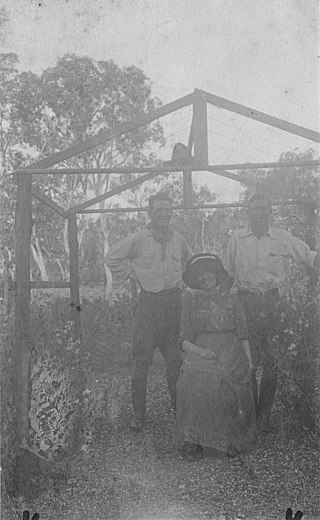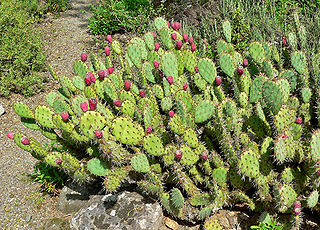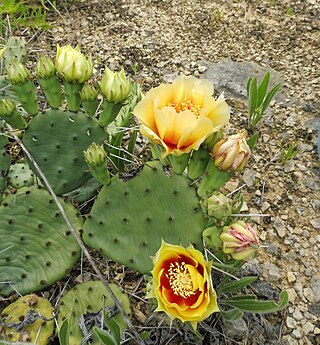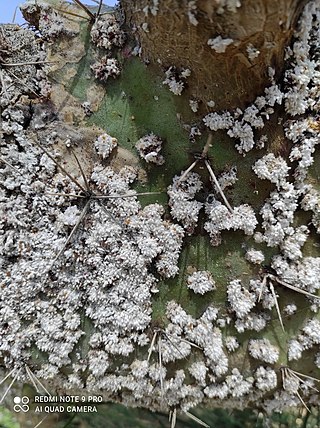
Nopal is a common name in Spanish for Opuntia cacti, as well as for its pads. The name nopal derives from the Nahuatl word nohpalli for the pads of the plant.

Invasive species in Australia are a serious threat to the native biodiversity, and an ongoing cost to Australian agriculture. Numerous species arrived with European maritime exploration and colonisation of Australia and steadily since then.

Opuntia ficus-indica, the Indian fig opuntia, fig opuntia, or prickly pear, is a species of cactus that has long been a domesticated crop plant grown in agricultural economies throughout arid and semiarid parts of the world. O. ficus-indica is the most widespread and most commercially important cactus. It is grown primarily as a fruit crop, and also for the vegetable nopales and other uses. Cacti are good crops for dry areas because they efficiently convert water into biomass. O. ficus-indica, as the most widespread of the long-domesticated cactuses, is as economically important as maize and blue agave in Mexico. Opuntia species hybridize easily, but the wild origin of O. ficus-indica is likely to have been in central Mexico, where its closest genetic relatives are found.

Rose Ethel Janet White-Haney, known as Jean White-Haney, was a botanist in Queensland, Australia. She was officer-in-charge of the Queensland Board of Advice on Prickly Pear Destruction and helped develop biological control methods for managing the invasive cactus.

Cactoblastis cactorum, the cactus moth, South American cactus moth or nopal moth, is native to Argentina, Paraguay, Uruguay and southern Brazil. It is one of five species in the genus Cactoblastis that inhabit South America, where many parasitoids, predators and pathogens control the expansion of the moths' population. This species has been introduced into many areas outside its natural range, including Australia, the Caribbean, and South Africa. In some locations, it has spread uncontrollably and was consequently classified an invasive species. However, in other places such as Australia, it has gained favor for its role in the biological control of cacti from the genus Opuntia, such as prickly pear.

Opuntia stricta is a species of large cactus that is endemic to the subtropical and tropical coastal areas of the Americas, especially around the Caribbean. Common names include erect prickly pear and nopal estricto (Spanish). The first description as Cactus strictus was published in 1803 by Adrian Hardy Haworth. In 1812 he moved the species to the genus Opuntia.

Opuntia bentonii was proposed by some botanists to be a synonym of Opuntia stricta. However, O. bentonii, which grows in Texas, is separate and distinct from O. stricta.O. bentonii was clearly described by Griffiths in 1911. Along with O. stricta,O. bentonii was one of the pest pears of Australia in the early Twentieth Century.

Opuntia, commonly called the prickly pear cactus, is a genus of flowering plants in the cactus family Cactaceae, many known for their flavorful fruit and showy flowers. Cacti are well-adapted to aridity, however, they are still vulnerable to alterations in precipitation and temperature driven by climate change. Prickly pear alone is more commonly used to refer exclusively to the fruit, but may also be used for the plant itself; in addition, other names given to the plant and its specific parts include tuna (fruit), sabra, sabbar, nopal from the Nahuatl word nōpalli, nostle (fruit) from the Nahuatl word nōchtli, and paddle cactus. The genus is named for the Ancient Greek city of Opus, where, according to Theophrastus, an edible plant grew and could be propagated by rooting its leaves. The most common culinary species is the "Barbary fig".

Opuntia aurantiaca, commonly known as tiger-pear, jointed cactus or jointed prickly-pear, is a species of cactus from South America. The species occurs naturally in Argentina, Paraguay and Uruguay and is considered an invasive species in Africa and Australia.

The Phycitinae are a subfamily of snout moths. Even though the Pyralidae subfamilies are all quite diverse, Phycitinae stand out even by standards of their family: with over 600 genera considered valid and more than 4000 species placed here at present, they unite up more than three-quarters of living snout moth diversity. Together with the closely related Epipaschiinae, they are apparently the most advanced lineage of snout moths.

Opuntia triacantha is a species of cactus known by the common names Spanish lady, Keys Joe-jumper, Big Pine Key prickly-pear, and jumping prickly apple. It is native to the Caribbean, from Desecheo Island, Puerto Rico, to the Lesser Antilles.

Dactylopius is a genus of insect in the superfamily Coccoidea, the scale insects. It is the only genus in the family Dactylopiidae. These insects are known commonly as cochineals, a name that also specifically refers to the best-known species, the cochineal. The cochineal is an insect of economic and historical importance as a main source of the red dye carmine. It has reportedly been used for this purpose in the Americas since the 10th century. Genus Dactylopius is also important because several species have been used as agents of biological pest control, and because several are known as invasive species.

Thomas Harvey Johnston was an Australian biologist and parasitologist. He championed the efforts to eradicate the invasive prickly pear.

Cactoblastis Memorial Hall is a heritage-listed memorial at Warrego Highway, Boonarga, Western Downs Region, Queensland, Australia. It was built in 1936 by Jack Schloss. It was added to the Queensland Heritage Register on 21 September 1993.

Opuntia rufida is a species of prickly pear cactus native to southwestern Texas and northern Mexico, where it grows on rocky slopes. The species makes up for its total lack of spines with a profusion of red-brown glochids. The common name blind prickly pear or cow blinder comes from the fact that the glochids may be carried away by the wind and blind animals.

Opuntia cespitosa, commonly called the eastern prickly pear, is a species of cactus native to North America. It is most common west of the Appalachian Mountains and east of the Mississippi River, where it is found in the Midwest, Upper South and in Ontario. Its natural habitat is in dry, open areas, such as outcrops, glades, and barrens.
Opuntia ficus-indica is a plant that has been part of the landscape of South Africa for over 250 years.
Springdale is a rural locality in the Southern Downs Region, Queensland, Australia. In the 2021 census, Springdale had a population of 28 people.

Opuntia austrina, also known as the Florida prickly pear, is a prickly pear cactus species that is endemic to Florida in the United States.

Dactylopius opuntiae, also known as the prickly pear cochineal, is a species of scale insect in the family Dactylopiidae.




















